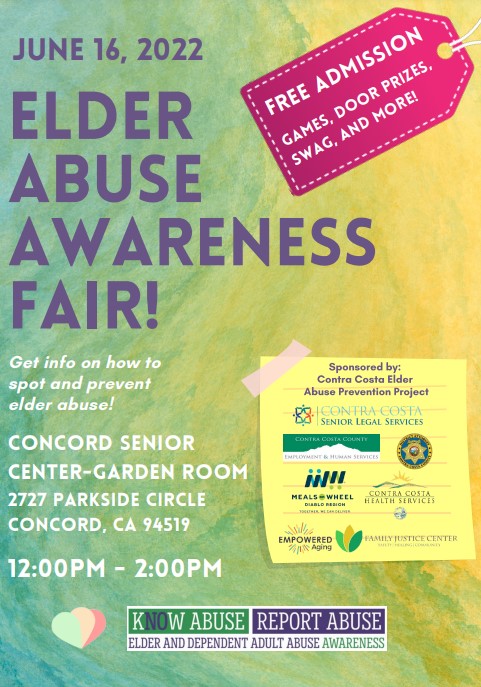June is Elder Abuse Awareness Month. The purpose this month is to raise awareness about elder abuse and spur communities to take steps to address and prevent elder abuse. While elder abuse happens in all communities and cuts across demographic lines, such abuse happens with far too little recognition and response.
Let’s use this month to change that and learn about elder abuse as it occurs in our own community. By teaching ourselves to spot elder abuse, we can put ourselves in a better position to help those who are being abused. In Contra Costa County from July 2020 to June 2021, Adult Protective Services received 5,390 allegations of elder abuse. As our population of seniors continues to grow, it is more important than ever that we protect our elders and educate our community about elder abuse.
Understanding what constitutes elder abuse is essential to helping prevent and address this problem. Many people believe that elder abuse means only physical abuse. On the contrary, elder abuse is far more than just physical abuse. Types of elder abuse include:
-
- Physical abuse, including misuse of medication, deprivation of food or water, and inappropriate restraint
- Sexual abuse, meaning a non-consensual sexual activity
- Mental or emotional abuse, including harassment and intimidation that causes emotional distress or fear
- Financial abuse
- Abandonment or neglect
- Isolation, meaning the systematic exclusion of all outside contact
- A caregiver depriving an elder of goods or services needed to avoid harm or suffering
- Any other treatment that results in physical harm, pain, or mental suffering
- Financial abuse: when a person takes the property of an elder for a wrongful use, or with the intent to defraud, if the person knew or should have known that this conduct is likely to be harmful to the elder. This also includes anyone who assists with financial abuse.
By learning about different types of elder abuse, we can improve our ability to help those who are experiencing abuse. In addition to recognizing what elder abuse is, take the time to learn the signs of these different forms of abuse. There are numerous signs of elder abuse, including:
- When an elder stops participating in activities they once enjoyed
- Looks messy or unkempt
- Trouble sleeping
- Unexplained weight loss
- Becomes withdrawn or acts agitated or violent
- Displays signs of trauma, such as rocking back and forth
- Has unexplained bruises, cuts, scars, or burns
- Broken eyeglasses or frames, or the elder shows other signs of punishment or restraint
- Develops bed sores or another preventable condition
- Lacks medical aids like glasses, hearing aids, or medication
- Hazardous, unclean, or unsafe living conditions
- Receives notice of eviction for unpaid rent, notice of late mortgage, or home eviction
- Shows signs of insufficient care or unpaid bills despite having adequate financial resources
If you see someone show these signs of elder abuse, support that person and connect them with services for victims of elder abuse. In Contra Costa County, we have many resources for people who are experiencing elder abuse. The Elder Abuse Prevention Program (EAPP) is a partnership of organizations around Contra Costa County that serve seniors who are experiencing some type of elder abuse. Visit http://cocoelderjustice.org/ to learn how to connect with the program and receive assistance with elder abuse. Contra Costa Senior Legal Services is a member of EAPP. We can help people aged 60 and older who are being abused. Call us at (925) 609-7900 to learn more about our services for victims of elder abuse.
